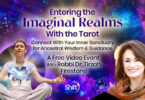Guest writer for Wake Up World
Originally published at lonerwolf.com and reproduced here with permission.
How often have you felt anxiety grip you so tightly that you freeze and can’t speak?
What about anger, grief, shock, jealousy, resentment, regret, and shame? How often have you felt these emotions overwhelm your entire nervous system to the point that you feel like (a) you’re going to explode, melt, or get sucked into a dark abyss (b) have a mental breakdown, or (c) go crazy … or die?
[pro_ad_display_adzone id=”110028″]
To the onlooker, these reactions to common emotions such as anger and shame might appear melodramatic. “Stop being so dramatic” or “get a thicker skin” we might be told. On the other hand, our friends and family may give us a sympathetic half-hearted pat on the back, but we can see out of the corners of our eyes their disbelief.
Being sensitive can be tough. But it is tougher when you weren’t taught how to regulate emotions, making life often feel too big and too intense to handle. You might resort to hiding away from people, giving up jobs, and putting up walls to shut people out. You might repress your emotions so that you become emotionally numb or find other ways to desensitize yourself through addictions.
If you have felt anger boiling so intensely within you that your entire body shakes, or sadness so strong that you cry for hours and hours, please read this article. Also, I want to mention before we start that this article isn’t solely written for people who identify as “sensitive.” I am writing a “sensitive person’s guide” because I have personally struggled with this issue as a highly sensitive person. Therefore, although I write through the eyes of a sensitive person, I intend this article to benefit anyone, regardless of their neurological wiring.
What is Emotional Regulation?
Emotional regulation is a term that refers to our ability to manage our emotions in a healthy way. When we are able to respond to difficult situations using healthy coping mechanisms, we can handle strong feelings such as anger and fear. But when we have unhealthy (or an absence of) coping mechanisms, we feel overpowered by our emotions.
Why Does Emotional Dysregulation Happen?
Emotional dysregulation is the opposite of emotional regulation: it is the inability to manage or cope with strong feelings. According to psychologists, emotional dysregulation starts in childhood and builds through repeated circumstances of stress and the absence of guidance from parents or caretakers. Children learn by observing adults and their responses to stressful situations. When we don’t have good role models growing up (i.e. parents who struggled with their emotions), we miss out on learning important coping mechanisms.
Struggling with intense emotions also happens when we are exposed to too many stressful situations as a child, e.g. divorce, moving, travel, family drama, accidents, tragedies, etc. When we don’t feel safely held, touched, seen, and helped to face these stressors, we lack resilience and develop poor “emotional immunity.” Emotional dysregulation can also occur when we aren’t exposed to enough minor stressors as a child, i.e. if we are sheltered too much from the world. Just like the body’s immune system, we must be exposed to minor sources of stress (e.g. having to wait our turn in the playground) to build up strong immunity.
Signs You Struggle With Emotional Regulation
There are two types of maladaptive behaviors when it comes to emotional regulation, and they are externalized behaviors and internalized behaviors.
Externalized behaviors occur when we channel our angst externally. Here are some signs:
- Explosive and uncontrollable anger
- Crying for hours
- Verbal or physical aggression
- Picking fights with others
- Destructive behavior (e.g. breaking things)
However, in my experience, these externalized symptoms tend to suit choleric types of people (i.e. fiery personalities) and are generally not expressed by highly sensitive people (although there are exceptions).
The other type of emotional dysregulation occurs as internalized behavior. For example:
- Obsessive worry
- Chronic intense anxiety
- Sadness and depression
- Emotional touchiness (becoming easily upset)
- Social withdrawal and self-isolation
General symptoms that are shared by both types of people (externalizers and internalizers) include:
- Feeling overwhelmed by everything
- Inability to handle pressure
- Unbearably strong emotions
- Constantly riding emotional roller coasters
- Tendency towards addiction
8 Simple Ways to Practice Emotional Regulation
If the ocean can calm itself, so can you. We are both salt water mixed with air.
— Nayyirah Waheed
As you read this list, don’t just skim through it. Reflect on it. Take it seriously. Plan to implement its advice. Notice which suggestions call to you and commit to them. I write this list from personal experience, so not everything will appeal or be relevant to you. Studies on emotional regulation have found that “one size doesn’t fit all” – in other words, play around. Adapt, merge or change the techniques mentioned below. Find what suits your style, your personality, your source of pain. By doing this, you will develop the tools you need to navigate through the choppy emotional waters you experience and feel safe again.
Here are my suggestions:
1. Get lots of sleep
Poor sleep reduces your ability to deal with stress. Ensure that you are getting a good 8+ hours of sleep. If you can’t sleep for that long, consider purchasing a herb like valerian or applying magnesium oil to your body before sleeping to encourage deeper and longer rest.
2. Journaling
If you tend to internalize your emotions like me, try to express them in a journal. Ensure this journal is private and for your eyes only (this will encourage full and uninhibited self-expression). Don’t be afraid to write down your deepest and darkest thought or feelings. Just let it all out. Treat journaling as a form of catharsis.
3. Physical catharsis
Emotions like anxiety and anger tend to get trapped in the body and energy field. Through time, when not released, they cause us to become hypervigilant and emotionally unstable. In order to purge this old stagnant emotional energy, try some form of catharsis. My favorite catharsis at the moment is boxing (which translates to punching the wall with boxing gloves on). Other forms of catharsis involve screaming (in a private place), crying, laughing, or doing intense physical workouts such as running, jumping, or doing fast-paced vinyasa yoga.
4. Self-soothing words
Our self-talk plays a huge role in our wellbeing and ability to cope with difficult circumstances. If you struggle with emotional regulation, try to pay attention to your thoughts. What is your mind telling you? Likely, you will hear things like “this is too intense,” “I can’t handle this,” “I’m going crazy,” “I’m embarrassing myself,” “this is scary,” and so forth. Obviously, this type of self-talk makes whatever you’re feeling one hundred times worse.
In order to manage your emotions, try creating a list of self-soothing words that you will turn to when you’re feeling overwhelmed. Examples may include:
- I’m doing well.
- I can do this.
- I take one step at a time.
- Calmness.
- Peace and serenity.
- It’s OK to feel scared.
- I go slowly and steadily.
- Breathe in. Breathe out.
- Compassion.
5. Ground yourself
Grounding yourself means staying connected to the present moment, or the “Eternal Now.” My favorite way to stay grounded is by practicing mindful awareness, i.e. paying attention to the environment around me. Read about mindfulness here. Here are some techniques:
- Notice your feet touching the ground; how does it feel?
- Breathe in and focus on the scents wafting into your nostrils.
- Look at the colors, movements, shadows, textures, etc. around you.
- Carry a crystal or object in your pocket and touch it whenever you feel triggered.
- Wash your hands and feel the cool water run over them.
- Focus on the movement of your feet as you walk saying “right … left … right … left” when you walk.
- Drink a warm beverage like tea.
- Clench your fists or toes tightly.
- Sit down somewhere in nature. Enjoy the sights, sounds, and smells.
- Breathe deeply and focus on your in-breath and out-breath.
6. Draw boundaries and take breaks
Don’t overextend yourself unnecessarily. When you feel tired, take a break. When you feel anxious, take a moment to pause and practice a grounding, self-care or self-soothing technique mentioned in this article. If someone is overstepping your boundaries, let them know either verbally or non-verbally. Practice being assertive and knowing your rights. You have the right to say “no” and relax. It’s okay to set clear boundaries.
7. Practice self-care
Self-care is self-love in action. What is self-love? Self-love is understanding, accepting, embracing, and looking after yourself. In the context of emotional regulation, self-care is doing anything that feels loving and beneficial for your well-being. This may include, for example:
- Wrapping yourself up in a warm blanket.
- Making yourself healthy comfort food.
- Taking care of yourself when you’re feeling sick and inundated.
- Playing soothing music.
- Getting out in the sun and taking a walk.
- Recharging in nature.
- Eating nutritious food to strengthen your body and mind.
- Talking with a friend or loved one.
- Seeking out a therapist.
- Walking away from toxic people.
The above examples are by no means exhaustive and they only list a few common examples. Try to think about what self-care means to you. Ask yourself, “what feels most self-loving right now?”
8. Connect with your inner mother/father and child
We are all multi-faceted. The inner child is one of those inner facets that we carry around – and he/she can be a source of tremendous insight and healing. When we get in touch with our inner child, learn to listen to him/her, and provide comfort, we are initiating a profound form of soul retrieval. As it was our child self who never learned how to deal with strong emotions, we can benefit a lot from teaching this innocent and vulnerable place within ourselves healthy coping mechanisms.
The inner mother or father is a less known inner character that we all carry, but one that I feel is vital for true healing to occur. Your inner mother or father is that place within you that emanates love and compassion. As a female, I choose to seek out my inner Mother when I am suffering from overwhelming emotions. Depending on your childhood, and which parent was most physically/emotionally/spiritually absent, you might differ.
Some of the best ways to contact your inner Father or Mother (I tend to refer to them as the “Divine Parent”) include dialoguing with them in your journal, doing mirror work (i.e. looking into a mirror and waiting for their presence to emerge), visualization, and meditation.
I wrote a great article about initiating contact and beginning your inner child work.
What is your experience with emotional regulation? I’d love to hear your story in the comments.
Finally, I encourage you to re-read through the advice above and genuinely consider what advice you plan to implement this week. Which practices sound the most promising to you? Try one out and let me know!
Recommended articles by Aletheia Luna:
- 25 Signs You Have a Wounded Inner Child
- Feeling Empty: 5 Ways to Heal Your Inner Void
- Crying Therapy: How to Stop Being an Emotionally Repressed Person
- The Ultimate Guide to Heart Chakra Healing for Beginners
- The Dark Side of Spiritual Healing That No One Talks About
- The Origins of the Spirit Animal, Totem and Power Animal
- Sound Healing Therapy: 14 Mystical Instruments That Induce Profound Relaxation and Inner Quiet
- 9 Ways to Awaken the Divine Masculine Within You
- How to Channel Your Soul Through Automatic Writing
- 6 Types of Energy Vampires That Emotionally Exhaust You
About the author:
Aletheia Luna is an influential spiritual writer whose work has changed the lives of thousands of people worldwide. After escaping the religious sect she was raised in, Luna experienced a profound existential crisis that led to her spiritual awakening. As a psychospiritual counselor, tarot reader, and professional writer, Luna’s mission is to help others become conscious of their entrapment and find joy, empowerment, and liberation in any circumstance. See more of her work at lonerwolf.com.
This article, The Sensitive Person’s Guide to Emotional Regulation, was originally published on lonerwolf.com, reproduced with permission.
[pro_ad_display_adzone id=”110027″]








